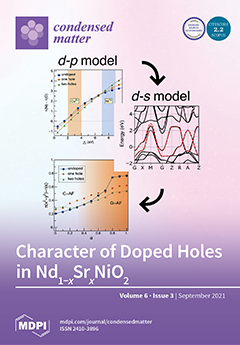AsF
3E as a representative of a molecular crystal has been chosen to find the precise localization of the lone pair (LP) E centroid 4s
2 of As
3+ and to enlighten the behavior of lone pair triplets of fluorine atoms. Starting
[...] Read more.
AsF
3E as a representative of a molecular crystal has been chosen to find the precise localization of the lone pair (LP) E centroid 4s
2 of As
3+ and to enlighten the behavior of lone pair triplets of fluorine atoms. Starting from stereochemistry rationale, Density Functional (DFT) electronic structure calculations yielding the electron localization (ELF) mapping led to precise large crystal structure evolutions from basic X-rays data (V = 267.2Å
3 at 193K), to (V = 230.5Å
3) and under Van der Waals forces (DEW) V = 206.4Å
3, and then under pressure P, all illustrated with ELF maps and band structures. Calibrated pressures up to 100 GPa exhibit the remarkable shrinking of all inter-atomic distances including As-E from 0.94Å down to 0.46Å, while the major three bonds As-F1, As-F2 and As-F3 are continuously expanding. The resulting picture of the application of pressure on AsF
3 molecular structure leads to the progressive immersion of the 4s
2 doublet within the electronic cloud with an original new status of As with its 4s
2 E expressed as [AsE]
3+. The expanded size becomes close to big LP-free K
+, Ba
2+ cations or LP characterized bismuth cation: [BiE]
3+, which appear inserted in cubes or square anti-prisms with coordination number 8 (CN8) or in tricapped trigonal prisms with CN9.
Full article





